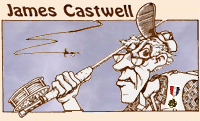|
I received an email today from a friend in
Europe complaining that almost all of the
magazines these days have nothing but the
same old basic information for guys new to
fly fishing. I suppose he may be right. Certainly
there is a lot of that in print over here too.
But, remember, it is the new guy who needs
information, at least he needs more of it than
the rest of us. You don't agree? Shouldn't we
write about the basics and then let those guys
learn the rest at their own speed, or should we
offer more for the ones who have progressed a bit?
It is a good and valid question. I don't have
the answer either. Who is to decide what is basic
and what is advanced? In casting, fishing, tying,
reading water, bugology; who is to say? Who can
stand a detailed dissertation on hooks or leaders
or line tapers or scrim? If a writer sticks to
basics he can be rather assured of a wide and
appreciative audience under most situations. To
delve into the advanced is to limit his targets.
The books of 'how to' far outweigh those on 'why to.'
I remember watching an instructor years back showing
how to pass a fly line through his wedding ring and
cast without a fly rod. Now, that is advanced. The
problem was the students had not picked up a fly rod
before that day. Basics may have been more in order.
When we were teaching fly-fishing for the University
of Michigan, we had scheduled three courses. Beginner,
intermediate and advanced. Guess what? Everyone signed
up for the advanced. Some had never touched a fly rod
before. We started the thirteen week course with the
basics and went on through the intermediate and into
the advanced. Worked fine. But you're right, we should
do more for the intermediate and advanced.
When we were running our school in Livingston, Montana,
on fly-fishing, we had one old gentleman sign up much
to the surprise of the gang at Dan Baileys. This guy
was known as the 'dean' of the Yellowstone River, had
fished it for decades. We were a bit amused to find
out that he could not cast. Really. All he could do
was roll-cast. He had a long slow rod and that was
all he did. Worked for him. He was like a kid at
Christmas when he learned real casting. What did
we teach him? Basics.
Once when we were running a spring 'tune-up' here
for T.U., an old fellow mentioned during a lunch
break that for all the many years he had been fly
fishing he never knew that 'stopping the rod' was
what made the line go. We had used some basics for
the start of the tune-up. So, who is to say just
what is basic and what is not. There seem to be
some who have twenty years experience and some
who have one years experience twenty times. The
problem is most do not know which group they belong
to. So here I go. This is for the intermediate and
advanced, way too technical for you new guys.
'How to string up a rod without
busting the thing.'
I will assume you are right handed for the rest of
this and crank with your left hand. Pull out more
fly line than the length of your rod. With your
left hand make a small loop of the line near
where the leader is attached. Start the loop
up through the stripping guide and the next
ones you can easily reach. You are holding the
rod with your right hand during this. Now lay
the butt of the rod on the grass with the reel
handles pointing up and step a bit to your left.
Continue threading the fly line thru the guides
(which are on your side of the rod facing you and
are very convenient). Keep walking to your left
and stringing the rod until you reach the end.
Holding the rod with your right hand on the tip,
carefully pull out all of the line and leader
until there is no slack between the tip of the
rod and the reel. Do not take your hand off of the
rod tip until this is complete. To do so will
offer a great chance of breaking the rod as knots
or coils catch going through the guides. Many rods
are broken just this way.
Now remember, to those of you who have not been
doing it this way, this is some of the intermediate
and advanced stuff you have been missing. We will
try to do more soon. ~ James Castwell
|



